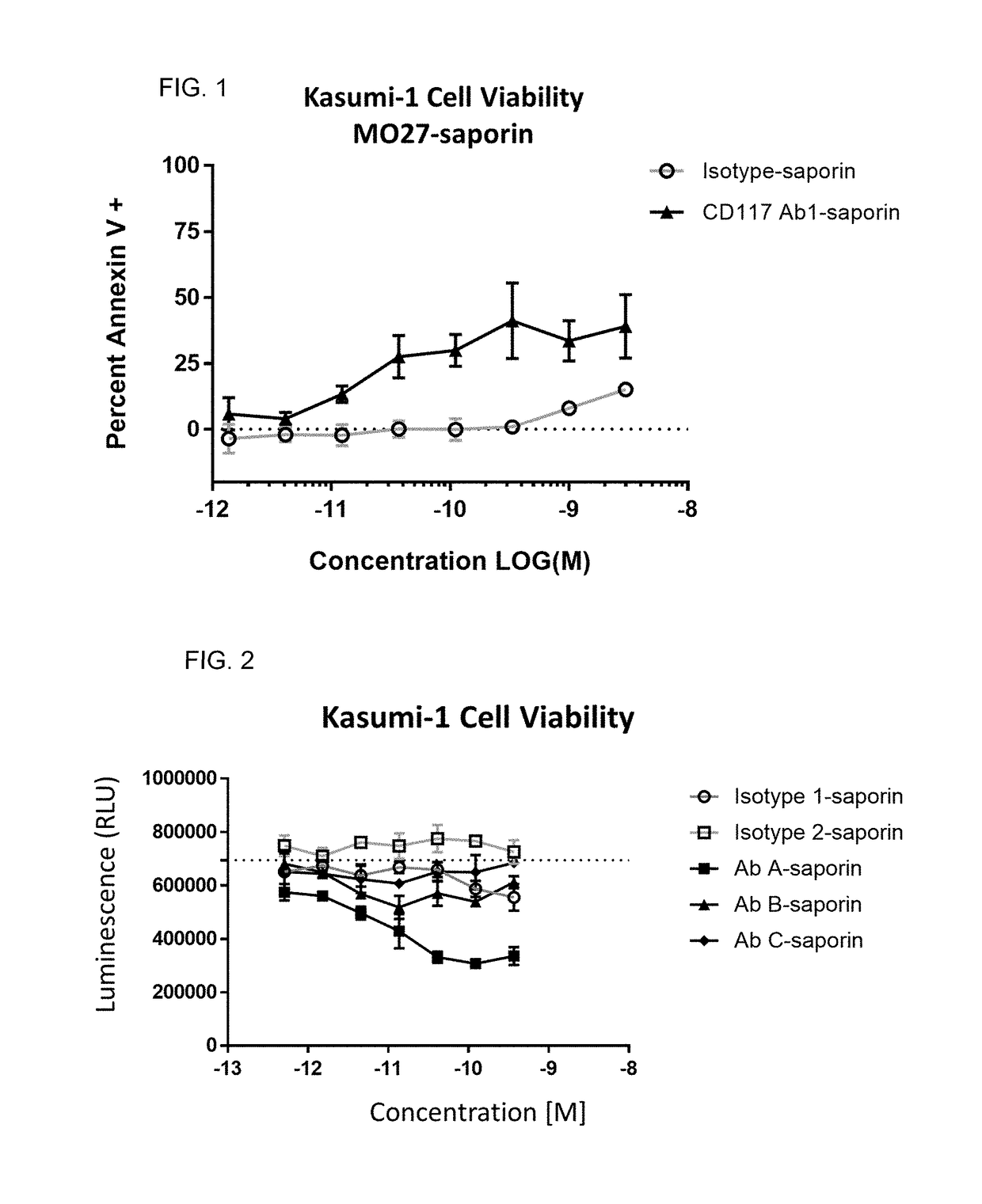Methods for the depletion of CD117+ cells
a technology of cd117+ cells and cd117+, which is applied in the field of treatment of patients, can solve the problems of preventing hematopoietic engraftment, affecting the use of cd117+ cells in the clinic, and affecting the engraftment of hematopoietic cells
- Summary
- Abstract
- Description
- Claims
- Application Information
AI Technical Summary
Benefits of technology
Problems solved by technology
Method used
Image
Examples
example 1
ation of an Anti-CD117 Antibody to a Human Patient in Preparation for Hematopoietic Stem Cell Transplant Therapy
[0503]Using the methods disclosed herein, a physician of skill in the art can administer to a human patient in need of hematopoietic stem cell transplant therapy an antibody or antigen-binding fragment thereof capable of binding an antigen expressed by hematopoietic stem cells, such as an antibody or antigen-biding fragment thereof that binds CD117 (for example, an antibody or antigen-binding fragment thereof that binds GNNK+CD117). In this fashion, a population of endogenous hematopoietic stem cells can be depleted prior to administration of an exogenous hematopoietic stem cell graft so as to promote engraftment of the hematopoietic stem cell graft. The antibody may be covalently conjugated to a toxin, such as a cytotoxic molecule described herein or known in the art. For instance, an anti-CD117 antibody or antigen-binding fragment thereof (such as an anti-GNNK+CD117 anti...
example 2
g Antibodies Capable of Binding Hematopoietic Stem Cells by Phage Display
[0507]An exemplary method for in vitro evolution of anti-CD117 (e.g., anti-GNNK+CD117) antibodies for use with the compositions and methods described herein is phage display. Phage display libraries can be created by making a designed series of mutations or variations within a coding sequence for the CDRs of an antibody or the analogous regions of an antibody-like scaffold (e.g., the BC, CD, and DE loops of 10Fn3 domains).
[0508]The template antibody-encoding sequence into which these mutations are introduced may be, for example, a naive human germline sequence. These mutations can be performed using standard mutagenesis techniques known in the art. Each mutant sequence thus encodes an antibody corresponding to the template save for one or more amino acid variations. Retroviral and phage display vectors can be engineered using standard vector construction techniques known in the art. P3 phage display vectors alo...
example 3
Humanized Antibodies that Bind a Hematopoietic Stem Cell Antigen
[0512]Non-human antibodies that bind CD117 (e.g., GNNK+CD117) can be humanized, for instance, according to the following procedure. Consensus human antibody heavy chain and light chain sequences are known in the art (see e.g., the “VBASE” human germline sequence database; Kabat et al. Sequences of Proteins of Immunological Interest, Fifth Edition, U.S. Department of Health and Human Services, NIH Publication No. 91-3242, 1991; Tomlinson et al., J. Mol. Biol. 227:776-798, 1992; and Cox et al. Eur. J. Immunol. 24:827-836, 1994, the disclosures of each of which are incorporated herein by reference as they pertain to consensus human antibody heavy chain and light chain sequences. Using established procedures, one of skill in the art can identify the variable domain framework residues and CDRs of a consensus antibody sequence (e.g., by sequence alignment). One can substitute one or more CDRs of the heavy chain and / or light c...
PUM
| Property | Measurement | Unit |
|---|---|---|
| concentration | aaaaa | aaaaa |
| time | aaaaa | aaaaa |
| time | aaaaa | aaaaa |
Abstract
Description
Claims
Application Information
 Login to View More
Login to View More - R&D
- Intellectual Property
- Life Sciences
- Materials
- Tech Scout
- Unparalleled Data Quality
- Higher Quality Content
- 60% Fewer Hallucinations
Browse by: Latest US Patents, China's latest patents, Technical Efficacy Thesaurus, Application Domain, Technology Topic, Popular Technical Reports.
© 2025 PatSnap. All rights reserved.Legal|Privacy policy|Modern Slavery Act Transparency Statement|Sitemap|About US| Contact US: help@patsnap.com



